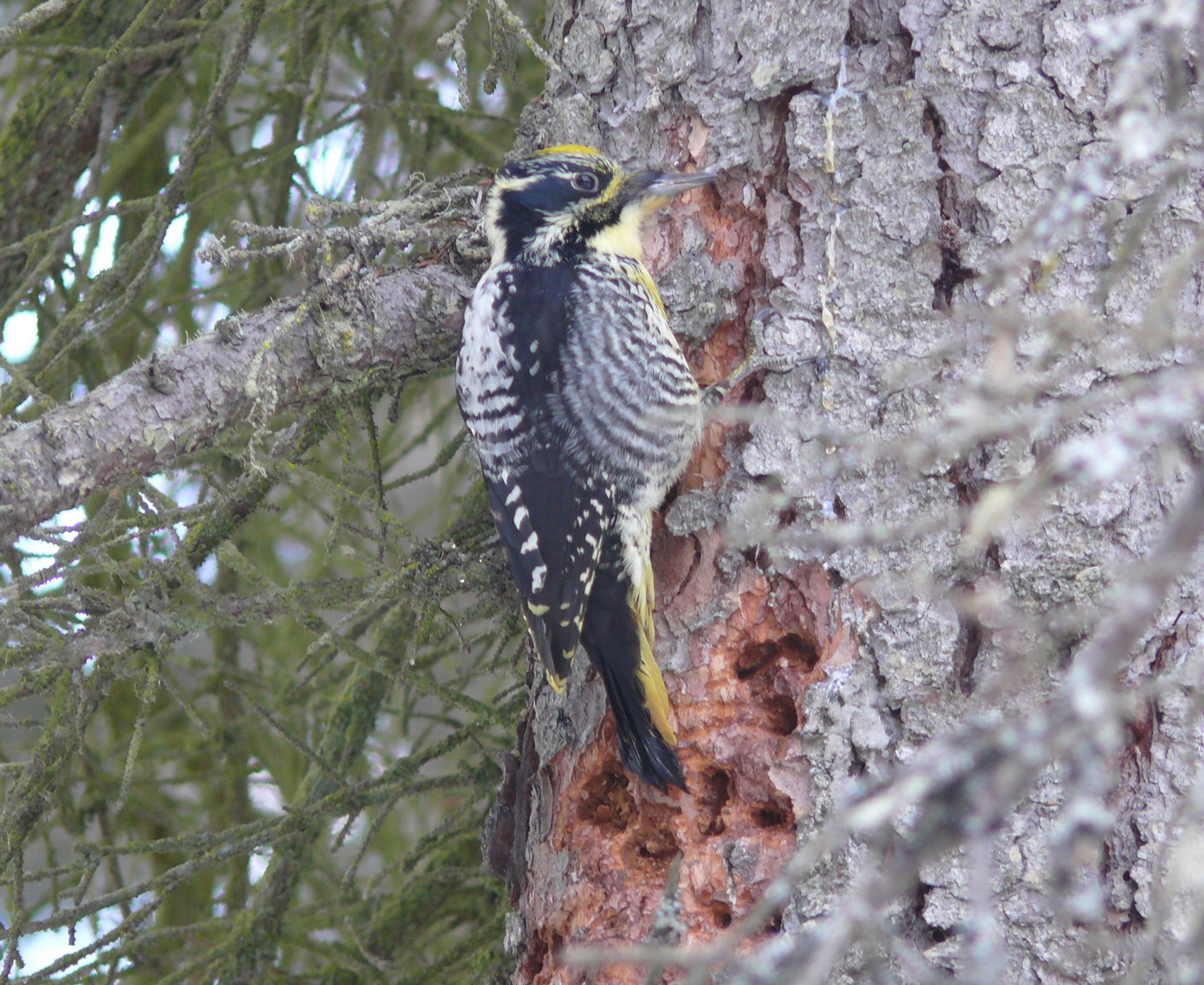A few years ago I received a call about an odd, unidentifiable bird. This is not an abnormal call to our office and we are glad to help whenever we can. This call piqued my interest as the caller described a woodpecker with yellow on the belly and face, but the rest of it was black and white. I asked for a photo and in fact the caller could do one better. Her cat had killed the bird and she held on to it for me. Normally, I would ask the person to return it to the wild in a place that it would not be consumed by their pets. In this case I had a clear vision that this was a Yellow-bellied Sapsucker.
Yellow-bellied Sapsuckers have been making a push into the Southcentral area since about 2013 so this was not a stretch, but it would provide an important data point. Upon inspection of the bird I realized my vision was totally off and this was “just” a Three-toed Woodpecker with yellow staining on the belly, face, tail and wingtips. Curiously, the bird did not have the yellow staining down the back. While not the exciting bird I thought it to be, it turns out to be even more of a mystery.
Stained feathers in birds are not uncommon. Waterfowl arrive at the Kenai Flats in spring with orange-colored feathers. Snow Geese, Northern Pintails and Sandhill Cranes get stained as they plunge their faces into the iron-rich mud in search of emergent vegetation.
Staining in songbirds is much less common. The only significant examples I found in the literature were several bird species that were stained by coal soot from air pollution during the start of the Industrial Revolution from 1880 to 1929. The museum specimens ranged from a dark gray to white based on the amount of coal soot that was being pumped into the air and then lightened in subsequent years as regulations began curbing our air pollution problems.
Over the next several years after viewing the yellow-stained woodpecker, I noticed yellowing in Gray Jays, Red-breasted Nuthatches and Boreal Chickadees at my feeder, but never in Black-capped Chickadees or Common Redpolls. Having inquired of fellow birders from around the state, it appears that the yellowing of certain species is restricted to the Kenai Peninsula. This phenomenon has been reported from Homer to Nikiski, but not from Anchorage or Fairbanks.
We next surmised that whatever birds were encountering that was causing the aberrant coloration was probably coming from spruce and likely not a dietary thing. All the species affected had a strong affinity for spruce forest while the black-capped chickadee that prefers deciduous or mixed forests was not affected. Also, since the backs of woodpeckers would rarely contact the tree it would have to be something on the trunk of the tree as opposed to an airborne stain like pollen floating all around the tree. We ruled out diet as that should affect all feathers equally.
Based on observations and speculations the mystery coloration appears to be the product of the Green Stubble Lichen, Calicium viride. This lichen has bright yellow to green soredia (granular outgrowths formed on the surface of the lichen that form a powdery dust). These soredia contain everything needed to land somewhere new and form a new lichen. The Green Stubble Lichen also produces short spore-producing stalks called apothecia. The lichen can spread via spores carried on the wind or by insects and animals to a new site or from soredia carried by insects and animals.
This species is found across the Western Hemisphere from Argentina to the Canadian Arctic. It is also quite common in Europe and Scandinavia. While most commonly found growing on coniferous wood and bark, it can be found on deciduous species.
The next step will be to confirm from one of our yellow birds if the coloration is indeed caused by contact with this lichen. We may be able to do this with microscopy or through chemical methods. If we can connect the dots to this lichen, a flood of new questions begin. Why is the Kenai Peninsula the only place that is seeing yellowed birds? There are plenty of other places in the world where this lichen occurs, so why are yellowish birds not being reported elsewhere? What has changed on the Kenai Peninsula as there is no mention of yellowing by previous bird surveys? We have had large, old spruce and presumably this lichen since Wilfred Osgood surveyed the Kenai Peninsula in the early 1900s.
If you would like to help with this exploration, we need to better document how prevalent yellowed birds are on the peninsula. We are looking for high-quality photos that clearly show yellowing in these spruce-dwelling bird species. You can email your photo, along with the coordinates or address and the date to todd_eskelin@fws.gov. Watch for an update as we try and sort out the mystery of yellowing birds across the Kenai Peninsula.
Todd Eskelin is a Wildlife Biologist at the Kenai National Wildlife Refuge. He specializes in birds and has conducted research on songbirds in many areas of the state. Find more information at http://www.fws.gov/refuge/kenai/ or http://www.facebook.com/kenainationalwildliferefuge.

